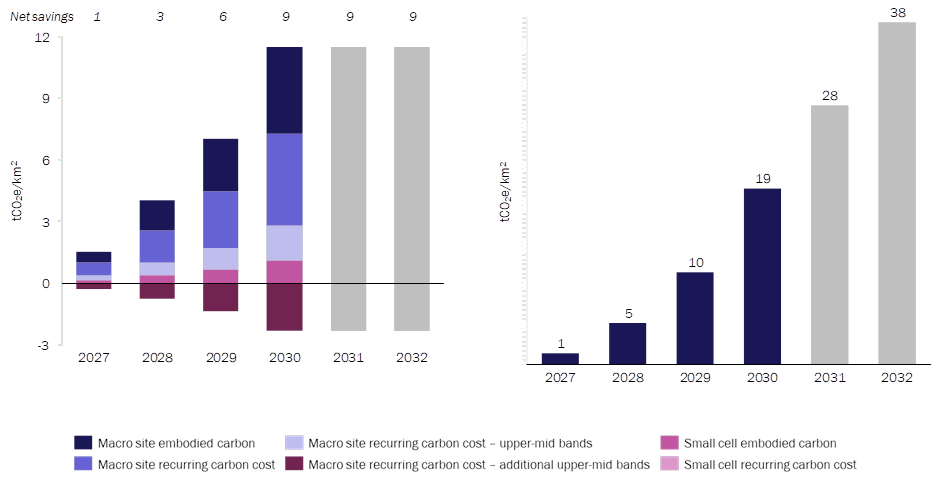Study assesses impact of spectrum deployment on carbon emissions from 5G infrastructure roll-out
24 July 2023 | Regulation and policy
Janette Stewart | Sylvain Loizeau | Julia Allford
Article | PDF (4 pages)
There is a current policy debate about the possible future uses of spectrum in the upper 6GHz frequency band (6425–7125MHz) in Europe. In addition, the mobile industry has indicated a requirement for additional 5G mid-band spectrum to meet future traffic demands. The upper 6GHz band is one that is being considered for this purpose, in some countries.1
Analysys Mason’s study investigated the carbon impact of mobile networks evolving to have more mid-band (for example, upper 6GHz) spectrum on existing sites, together with some densification, compared to building more base stations (‘further densifying’), to meet future market demands without having further mid-band spectrum available.
This study therefore provides a different perspective compared to other studies already undertaken on use of the upper 6GHz band, which have variously considered factors such as infrastructure deployment, financial viability, impact of spectrum in terms of coverage and QoS, etc.
Study assumptions
In our study, we do not model mobile networks at their national scale, but we have modelled two representative environments – a typical European city and a European rural location. In the European city, we modelled the future connectivity needs for mobile broadband (MBB) services, and in the European rural area, we assumed a combined use of mobile networks for MBB plus 5G-based fixed-wireless access (FWA), delivering broadband connectivity to homes and businesses.
The models do not represent specific locations, but hypothetical areas, defined based on modelled characteristics such as population density and occupants per household. We made assumptions about current mobile infrastructure deployment using typical urban and rural inter-site distances and considered how these deployments would need to evolve to meet future connectivity targets, either with more mid-band spectrum, or without. The future targets were based on European connectivity policy (the Digital Decade Policy Programme) together with objectives defined by the ITU for 5G deployment – that by 2030, MBB users might require downlink speeds of 100Mbit/s and uplink speeds of 50Mbit/s (which is in line with ITU targets for 5G), and for FWA, 1Gbit/s downlink (which is in line with European targets as per the Digital Decade Policy Programme).
The study was focused on the infrastructure-related carbon emissions – that is, carbon emissions in the production and operation of base stations. It did not consider the carbon impact of mobile devices, nor did it consider the enablement impact of mobile networks on other sectors (for example, by enabling other sectors to improve their efficiency with real-time or remote operations, etc). More specifically, the overall aim was to consider whether having more mid-band spectrum available assists in meeting the future connectivity targets with fewer additional macrocell sites and small cells needed. Our modelling scenarios thus compared the number of sites (macro, and small cells) needed to deliver future connectivity targets to a segment of users (defined by an ‘activity factor’ in our report) with, and without, additional mid-band spectrum. The characteristics of the mid-band spectrum such as bandwidth and spectral efficiencies were aligned with expectations for the upper 6GHz band.
We estimated the annualised carbon costs of the deployment scenarios with and without the upper 6GHz being attributed to mobile. The carbon costs were a combination of embodied cost, which is the construction and installation stage of the incremental base stations, plus recurring costs of operating the base station in terms of powering and maintaining the additional sites. We assume that passive equipment (for example, the sites themselves) has a lifetime of 20 years whereas active equipment (for example, antennas and radios) has a lifetime of 8 years. When adding new sites into our model, we assume those new sites are not only equipped with the upper mid-band spectrum that the study is considering, but that they would also be equipped with radios that operate using the existing bands already assigned for mobile use. Hence the embodied cost of building a new site includes building the site as well as passive and active equipment for all mobile bands deployed on the site. The recurring carbon cost (that is, the additional power needed to run the site) is split between existing mobile bands, existing 5G mid-band (that is, in the 3.5GHz band) and the upper mid-band. The recurring cost has a fixed and a variable component, reflecting the fact that power consumption is dependent on the network load.
We followed a traditional capacity modelling approach in which we calculated the capacity of base stations based on spectrum deployed (we assume a typical European portfolio of low, mid and high bands, plus small cells), spectral efficiency and demand assumptions (which are based on the evolution of 5G penetration and user requirements to reach the target levels in 2032).
Key findings
The study results show that although the carbon emissions of 5G base stations increase due to adding upper 6GHz radios to existing base stations, the carbon effect of deploying more base station sites (that is, densifying the network grid) is greater (due to increased number of sites, which have a carbon impact both in constructing and running the new sites) than the carbon effect of adding spectrum to existing sites (with a lesser degree of densification). Thus, carbon emissions are lower in the scenario in which the upper 6GHz band is available because fewer macrocell sites and small cells are needed for future connectivity.
The main results of the study are as follows (Figure 1 and Figure 2).
It should be noted that the recurring carbon costs shown as negative in the figures below are the incremental carbon costs of deploying the upper mid-band spectrum. The spectrum roll-out in our model is completed by 2030 – the diagrams below show the modelled outputs up to 2030, and assume this final roll-out applies thereafter to 2032 (shown by the grey bars for 2031 and 2032).
Figure 1: Annual carbon impact and cumulative carbon savings per dense urban km2

‘Upper mid bands’ refers to spectrum in the 3.5GHz range, which is already available to European mobile network operators (MNOs) and is being used today for 5G services. ‘Additional upper mid bands’ refers to further upper mid-band spectrum that would be available to European MNOs if the upper 6GHz band was to be available for 5G use. We assume that the spectral efficiency of the additional upper mid bands is higher than that of the current upper mid bands, in light of expected technology improvement by the time additional upper mid band spectrum is deployed (which, in our model, is 2027). Recurring carbon costs for the additional upper mid band spectrum are assumed to be similar to the current upper mid band, comprised of a fixed and a variable component (with the variable component being dependent on network loading).
Figure 2: Annual carbon impact and cumulative carbon savings per rural town or village km2

Without adding the upper 6GHz spectrum to the network deployment, our study shows that significant network densification may be required. This might also be beyond the practical limits of densification. This is because densification either via additional macrocells or via small cells, presents practical challenges such as finding suitable locations, sufficient space on sites, public resistance to proliferation of sites, and technical challenges such as increased interference.
1 Future spectrum for mobile use in the context of the ITU’s definition of ‘International Mobile Telecommunications’ has been widely debated in the lead up to the 2023 World Radiocommunications Conference (WRC-23). Our study was not related to estimating future spectrum needs, but a summary of what the mobile industry has previously estimated as an additional spectrum need can be found here: GSMA (June 2022), GSMA Reveals 5G Spectrum Needs for 2030 Across Low, Mid, and High Bands.
Article (PDF)
DownloadAuthors

Janette Stewart
Partner, expert in spectrum management, policy and valuation
Sylvain Loizeau
Principal, expert in telecoms strategy and regulation
Julia Allford
ManagerRelated items
Article
Policy makers must explore all possible levers to achieve gigabit connectivity ambitions
Report
AI for connectivity: how policy makers can help digitalisation
Report
LEO satellite broadband: a cost-effective option for rural areas of Europe

